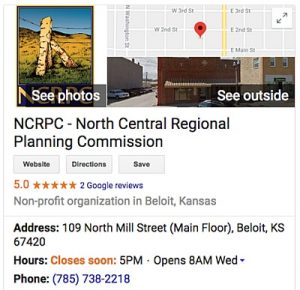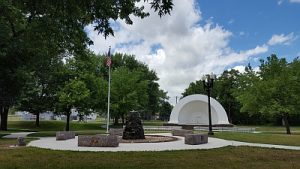Written by Doug McKinney, NCRPC Executive Director
An internship is a way for young adults to get credit for real-world experience. Interns work with an organization engaging in activities that provide them with new learning while benefiting the host organization. One funding source for internships is the Dane G. Hansen Foundation Community Intern Initiative. It matches Northwest Kansas communities or organizations that have a specific need with upper-level college students to address that need during a summer internship.
Communities or organizations first identify a community improvement project — such as downtown revitalization planning; community website/marketing; park or trail improvement; design for re-purposing an old building; or a host of other possibilities — and then apply to host an intern to assist with the project beginning in late May and ending in early August. Hosts in 2018 were City of Belleville, Jewell County Economic Development, Lincoln County Economic Development Foundation, North Central Regional Planning Commission, Ad Astra Music Festival of Russell and Wallace County Community Foundation.
Emily Reno, 2018 Hansen Intern for NCRPC, focused on food system information gathering as part of a regional food system assessment the NCRPC is doing in 2018 and 2019.
“While the first day on the job gave me somewhat of an indication of what my summer would look like, it in no way prepared me for the friendships I was to form in just a short period of time. And little did I know that I would soon find myself immersed in rural culture down to every last county fair, harvest festival, and Fun Day,” Reno said. “North Central Kansas is truly a unique place. Enough for me to consider it as a place I could come back to and call my home.”
Two interns with Lincoln County Economic Development Foundation focused on downtown building façade improvements. Some of the signage and improvement ideas they laid out will occur yet this year.
“It was definitely worthwhile,” Kelly Larson, Lincoln County Economic Development Foundation Executive Director, said.
Russ Piroutek, Belleville City Clerk, said the city hosted an intern who was able to work on community center concepts for the downtown area and gain a great deal of public feedback about the ideas generated.
Jewell County hosted two interns in 2018. They worked on deteriorating building and spatial development options in various downtown areas. They also worked with the Jewell County Health Coalition on fitness center options.
“It was a great project with lots of value,” Jenny Russell, Coordinator for Jewell County Community Development Association, said. “Hansen support was imperative!”
Another example of a successful internship program is the Nex-Generation Student Internship Program. In 2018, 56 businesses across Northwest and North Central Kansas hosted 68 high school and college interns.
“One of our main objectives is to expose students to Northwest and North Central Kansas workforce opportunities at an early age and encourage them to look for jobs right here at home,” Mendi Anschutz, Nex-Tech’s Economic Development/Networking Specialist, said. “We launched this program through Nex-Tech in 2011 with 6 interns. Three years ago, we opened up the program to local businesses, and a true culture shift has begun.”
At the conclusion of her internship, Emily Reno wrote a Letter to the Editor at the Beloit Call. To read the letter, visit www.ncrpc.org/2018intern.
For more information about the Hansen Intern Initiative, click here. The deadline for communities to apply to host summer interns is October 31, 2018. For more information about the Nex‐Generation Student Internship Program, click here. Businesses interested in hosting interns should contact Nex-Generation before December 2018.
This column appeared in the September 2018 NCRPC Newsletter.

 High school seniors in North Central Kansas are invited to compete for a chance to win $850 by submitting an essay or video in the 2018-2019 Rural Voices Youth Contest. The NCRPC sponsors the contest and has awarded more than $20,000 to seniors from around the region since 2006.
High school seniors in North Central Kansas are invited to compete for a chance to win $850 by submitting an essay or video in the 2018-2019 Rural Voices Youth Contest. The NCRPC sponsors the contest and has awarded more than $20,000 to seniors from around the region since 2006.




